This post may contain affiliate links via Amazon's affiliate advertising program. See privacy policy
If you’re looking for an exciting and delicious rice alternative to the same old boring side dishes, Gullah or Charleston red rice is a must-try. Originating from the coastal city of Charleston, South Carolina, this dish will tantalize your taste buds with its combination of aromas and flavors derived from generous amounts of onion, peppers, tomato sauce, garlic, and herbs like thyme.
Related Rice Posts:
- Jollof Rice
- Coconut Rice
- Garlic Fried Rice
Most people think of a Mexican red rice recipe (arroz rojo) when the topic of red rice comes up, but the South got something to say! Whether you serve it as a side dish or as your main course - even topping it off with some fried shrimp or chicken! - this red rice recipe is sure to be an unforgettable experience.
So what's the 411 with this comfort food dish?! Like most recipes on this site, I try to take what I know and put my own spin on things. Working with red rice is no different. I took tradition and built on it as part of Eat The Culture's annual black history month potluck.
In 2023, the theme of Black History Month is Black Resistance and Eat The Culture is recognizing the remarkable and, frankly, underrated resistance of our ancestors in bringing culinary traditions across the Atlantic to shape the vibrance of Black cuisine that we know and love today.
They physically and mentally carried African foodways across the deadly Middle Passage to pass down through generations. This year’s Black History Month Virtual Potluck traces popular dishes of the Diaspora from their West African roots to North America and beyond.

In 2023, the theme of Black History Month is Black Resistance and Eat The Culture is recognizing the remarkable and, frankly, underrated resistance of our ancestors in bringing culinary traditions across the Atlantic to shape the vibrance of Black cuisine that we know and love today.
They physically and mentally carried African foodways across the deadly Middle Passage to pass down through generations. This year’s Black History Month Virtual Potluck traces popular dishes of the Diaspora from their West African roots to North America and beyond.
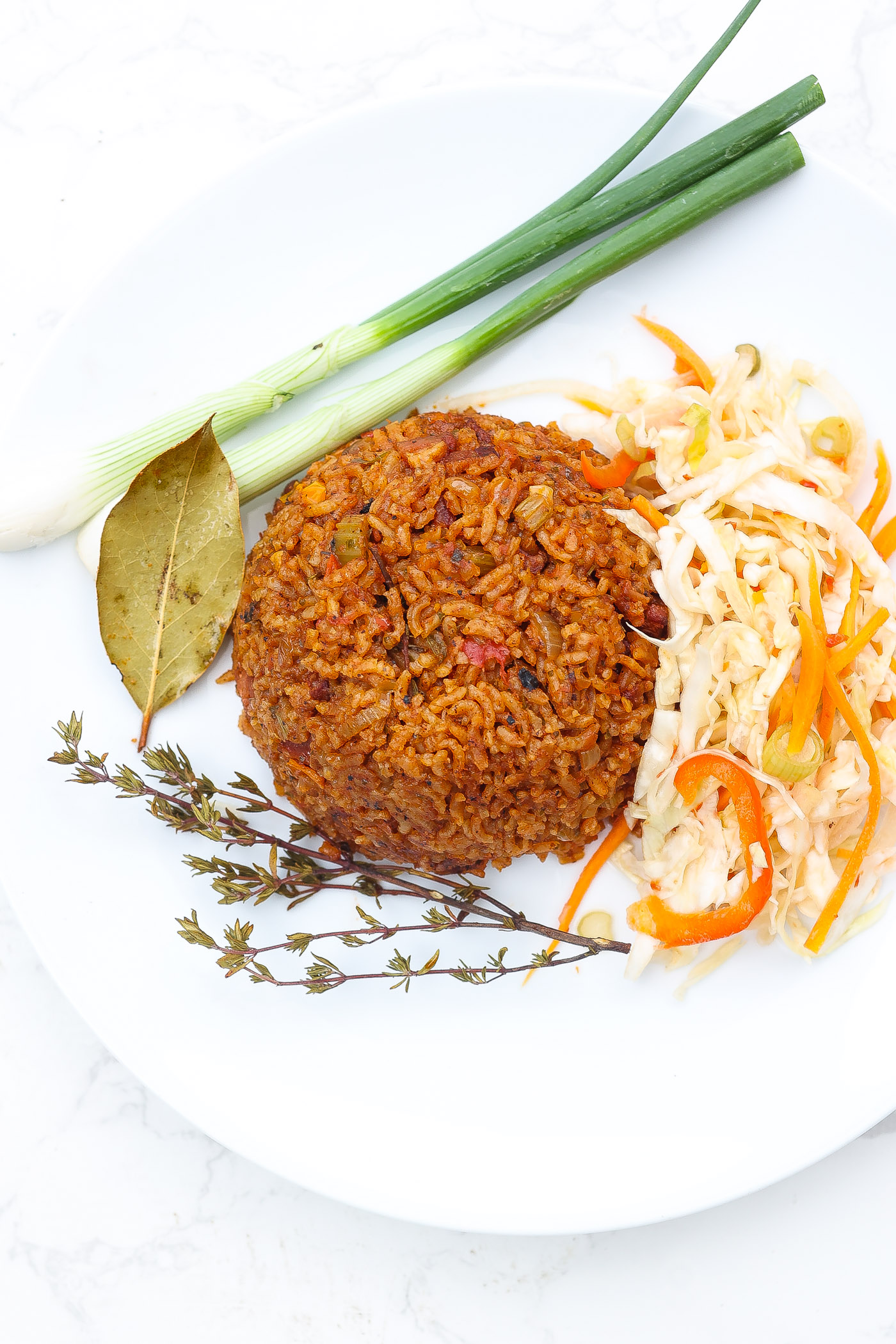
Connection to (West Africa) Nigerian Jollof Rice
Every culture has a rice dish. You got a red beans and rice, arroz con pollo, Jamaican rice and peas, etc. but unlike Jollof rice, few are the mother dish to others across the globe and several dishes in between.
It is a savory main dish that combines okra, meat, fish, and spices cooked in palm oil. It has traveled with our ancestors from Nigeria to be adopted in South America and the American South.
Jollof comes from the Senegambia region of West Africa, particularly Senegal. It’s a fragrant and flavorful combination of rice, onions, tomatoes, and fish or meat that can be traced from West Africa to the Caribbean, Mexico, and the American South. Today,
I’m teaching you how to make Red Rice from Charleston, South Carolina and encourage you to follow the story through Jollof Rice from Nigeria and Jambalaya from New Orleans, Louisiana.
Share these recipes with your friends and loved ones and follow each participant by using the hashtag #BHMVP2023 on Instagram. You can grab the full list of recipes from this year’s collaboration on the Eat The Culture website.
Beats and Eats (music to pair with Charleston Red Rice)
Rice started in Africa yet it's impact is felt everywhere around the world in a major way. Rice is like the hip hop of food. Think about hip hop as a music genre. It feels like its presence is entrenched in every aspect of culture worldwide. It's versatile and malleable enough to be customized to the different expressions of different folk.
The Women Kings of Rice
African rice cultivation has a long and rich history dating back deep into ancient times possibly over 2,000 years ago. From West Africa, rice cultivation spread across the continent and became a staple food in many regions.
Rice farming has historically been women's work. It was African women's knowledge and cultivating skills that were exploited via slavery to plantation empires and generational wealth in the American South, Caribbean, and South America. It's ironic, but in a very twisted way, because the secret transportation of rice during the Transatlantic slave trade was a form of resistance and survival.
Rice not only sustained the body, but nourished the soul as people were able to retain parts of themselves by bringing something familiar to the horrible situation they were forced into. Despite all they faced, Africans had the guile and agency to not only figure out a means to bring rice from their homeland but also how to cultivate it on a mass level in their new unfamiliar world and in spite of the trauma.
African rice has been an important staple crop for centuries. The rice is a testament to the ingenuity of African agriculturalists who relied on their own traditional methods of farming and developed rice production techniques that blended existing knowledge with innovative practices.
Rice, like in other parts of the world including Asia and the Caribbean, has become a mainstay in many African diets, especially along the coasts of East and West Africa where conditions are most favorable for its growth.
Rice farmers still use many of their ancestors’ methods that have been passed down through generations, allowing societies to continue to take advantage of the highly valuable grain.
From Africa to the American South
The Gullah people of the coastal plains of South Carolina and Georgia are renowned for their rice cultivation skills. Like many of the African ancestral traditions Gullah people have preserved, that deep rice cultivation knowledge changed economies of the colonial South.
While rice production in the colonial era was mostly done with enslaved African labor, some rice farmers were able to purchase their freedom through careful rice farming.
After emancipation, many freed people stayed in the area and continued rice production using clever agricultural practices, such as a technique called “sack fertigation” that allowed them to grow rice in low-lying areas unsuitable for larger-scale rice cultivation operations.
In particular, women have passed down traditional rice harvesting methods and have played an important role in cultivating rice as well as maintaining the Gullah culture itself. The Gullah are an inspiring example of resilience and industriousness, one which continues to be an integral part of our nation's history today.
The rice-cultivating history of the Gullah culture is impressive. Originating in the 16th century, rice was grown throughout rice plantations all around the Sea Islands and Low Country of Georgia and South Carolina, as a primary crop by enslaved West African people in rice fields that were often inundated with fresh water.
The rice they produced had a unique flavor and texture profile, perfect for culinary dishes all over the region. Utilizing the aquatic environment to their advantage, it's said that rice production from this farming method was incredibly productive compared to any other land-cultivated rice. Thanks to their ingenuity, today, Gullah rice is still enjoyed by many.
Rice is now an important staple food in many parts of the world and has a significant impact on global foodways for the following reasons:
- Versatility: Rice can be prepared in many different ways, making it a versatile ingredient in various cuisines. It can be boiled, steamed, fried, or baked and is used in dishes such as stir-fries, rice pudding, sushi, and rice pilaf.
- Cultural significance: Rice is often central to cultural celebrations and religious rituals in many parts of the world, especially in Asia. For example, in Japan, rice is considered a symbol of prosperity and is served at weddings, births, and other special occasions.
- Availability: Rice is a hardy crop that can grow in a wide range of climates and soils, making it readily available and accessible in many countries.
- Economic impact: Rice is one of the world's largest agricultural crops and provides food, income, and employment for millions of people globally. It is also a major export commodity for many countries, contributing to their economies.
These factors highlight the significance of rice in worldwide foodways, making it a staple food that has shaped and continues to shape the diets and food traditions of many cultures. This all started in Africa!
What is Gullah Red Rice
Gullah Red Rice is a traditional dish in the Gullah culture of South Carolina and Georgia, United States. It is made with long-grain rice that is cooked with bacon, onion, and garlic, then seasoned with tomato sauce and spices to produce a flavorful, red-colored dish. It is often served as a side dish or as a main dish with seafood.
What is the history of Red Rice?
Gullah Red Rice has roots in West African and Caribbean cuisine brought over by enslaved Africans to the Lowcountry or coastal regions of South Carolina and Georgia. The dish is a staple in the Gullah culture, which is known for preserving African cultural traditions and cuisine despite centuries of slavery and oppression.
The rice is flavored with ingredients readily available in the Lowcountry, such as bacon, onion, and garlic, and is often made with a tomato sauce for added flavor and color. The dish is still enjoyed today in the Gullah community and is considered a symbol of their cultural heritage.
Mexican Red Rice vs. Charleston Red Rice
Mexican rice and Charleston red rice are both delicious rice dishes but have distinct differences in flavor and ingredients.
Authentic Mexican rice, also known as Spanish rice, is typically made with long-grain white rice cooked in a tomato-based broth seasoned with onions, garlic, cumin, and sometimes chili powder. It often includes vegetables like tomatoes, bell peppers, and peas. The result is a flavorful, slightly tangy rice dish with a reddish hue from the tomatoes that accompanies many a Mexican meal.
On the other hand, Charleston red rice is a Southern American dish that features long-grain white rice cooked with bacon or sausage, onions, bell peppers, and sometimes celery. The key ingredient that gives it its distinct red color is crushed or diced tomatoes, which are added along with broth or water to cook the rice. Spices like paprika, black pepper, and sometimes cayenne pepper are used to season the dish, giving it a mildly spicy and smoky flavor.
While both dishes use tomatoes as a base and share some common ingredients like onions and bell peppers, the seasoning and overall flavor profile of Mexican rice tend to be more influenced by Mexican spices like cumin and chili powder, whereas Charleston red rice leans towards a Southern American flavor with smoky and savory notes from the bacon or sausage.
Ingredients Needed For Gullah Red Rice
For the Rice
- Long grain white rice - I prefer Carolina Gold Rice or Jasmine Rice vs. basmati rice
- Olive oil
- Thick cut bacon
- Andouille sausage links
- Garlic cloves
- Yellow onion
- Bell peppers
- Celery stalks
- Tomato paste
- Crushed Tomatoes
- Haitian Epis Seasoning Base - seasoning base of herbs, garlic, and peppers used like a sofrito
- Hot Sauce - use your preferred. I'm partial to Caribbean ones.
- Chicken Stock
- Bay leaf
- Fresh Thyme
Spice Seasoning Mix
- Dried thyme
- Kosher Salt
- Black Pepper
- Smoked Paprika
- Allspice
How To Make Gullah Red Rice
Make The Spice Seasoning Mix
Place all the spices in a small mixing bowl or ramekin and mix well. Set aside
Prepare the Rice
Rinse the rice in your sink until the water runs clear. Drain and set aside.
Cook the Rice
Pre-heat the oven to 350 degrees F.
Add oil to a large sauce pan or cast-iron skillet and cook bacon on low heat. Cook stirring often until bacon crisps about 5 minutes and the fat renders.
Increase heat to medium high heat. Add the andouille sausage and cook another 3-4 minutes. Remove both the bacon and sausage and set aside on a paper towel lined bowl or plate.
Add onions and celery to the skillet and cook 5 minutes.
Add the diced green bell pepper, garlic, and a quarter of the spice mix and cook for another minute.
Add the tomato paste and half the remaining spices and cook stirring constantly for about 8-10 minutes.
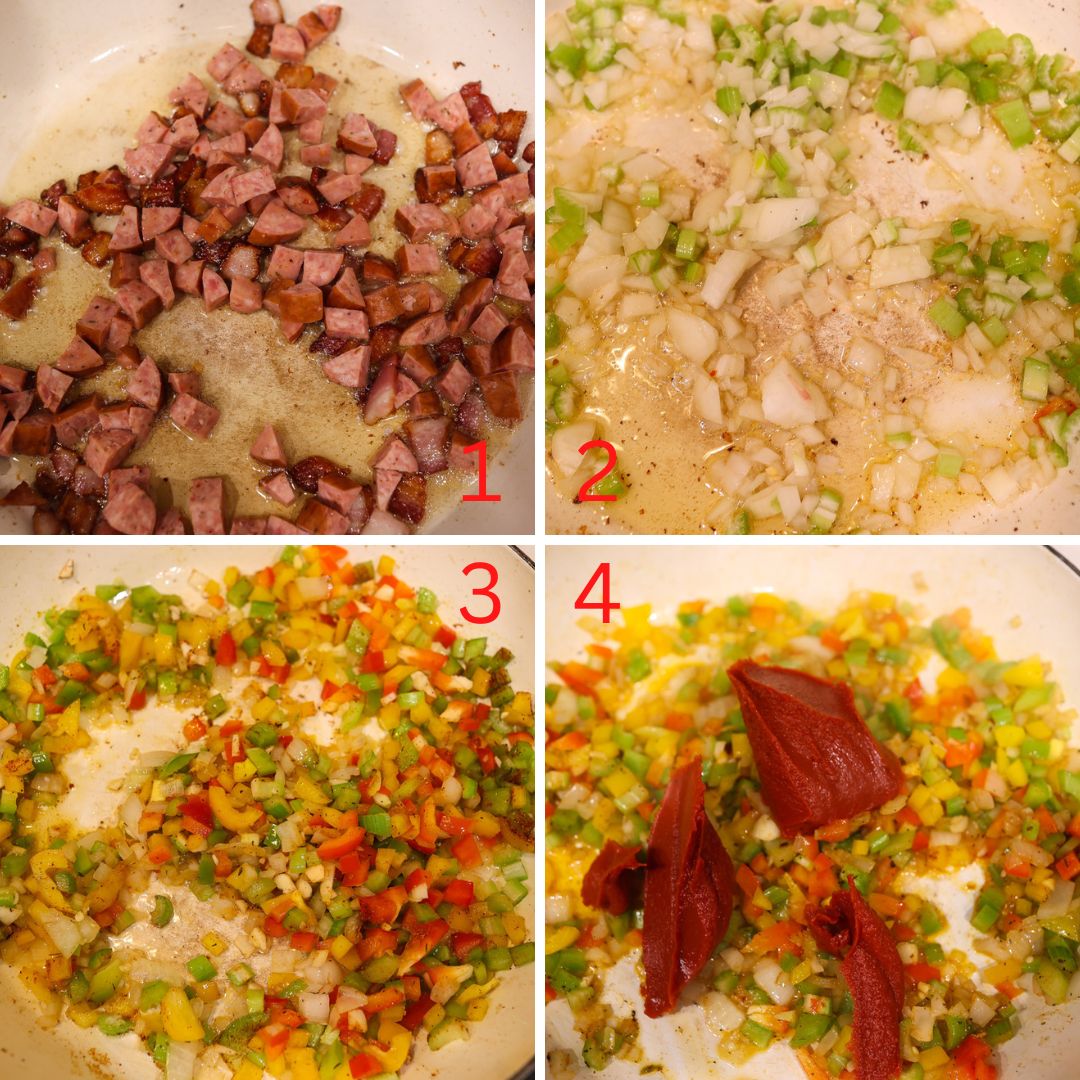
Add the rinsed rice and stir until coated well by the tomato paste mixture. 3-4 minutes
Add the Haitian Epis, crushed tomatoes and hot sauce. Mix well.
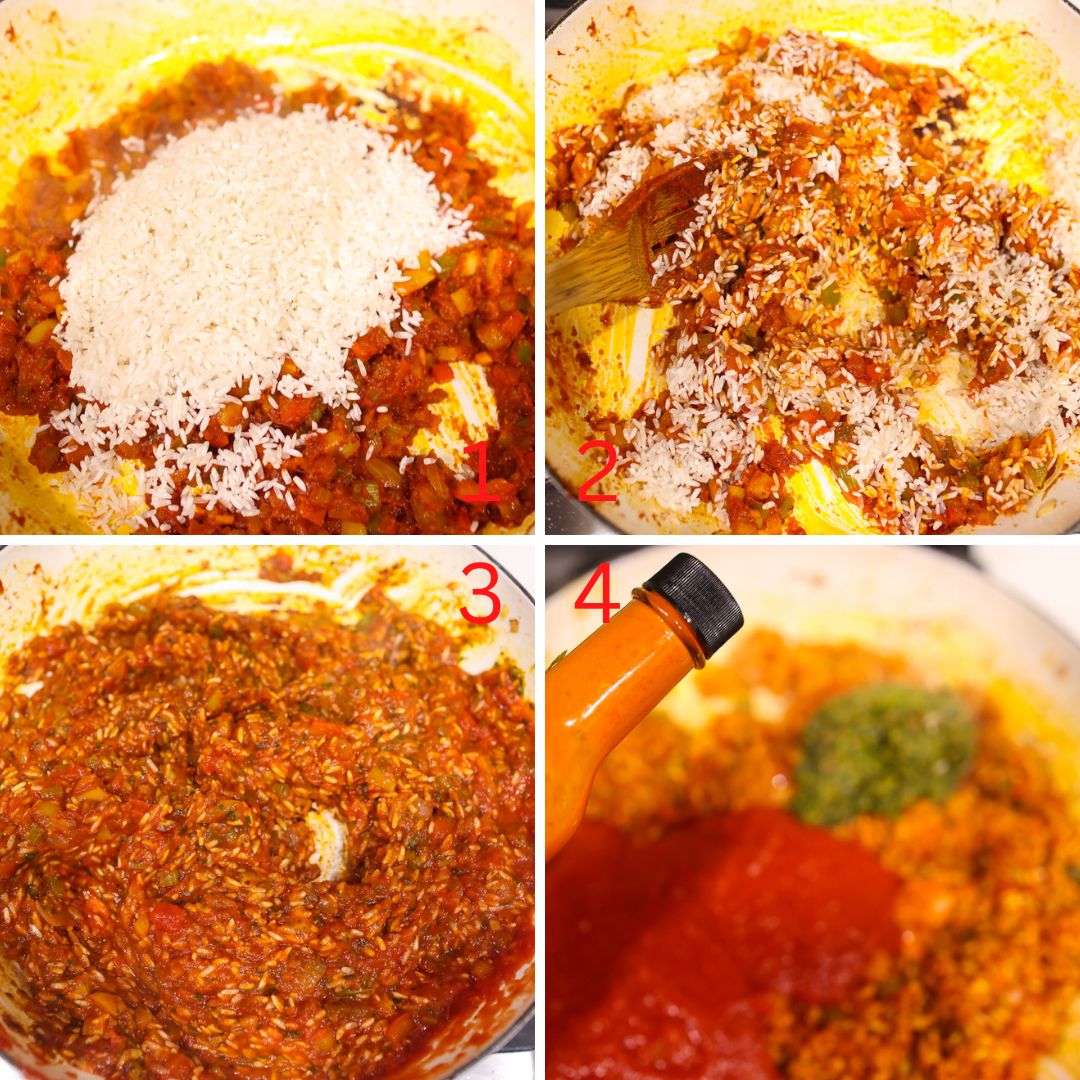
Turn off the heat and add the crumbled bacon plus sausage back. Then add the chicken stock, fresh thyme, and bay leaves. Cover the skillet with a tight fitting lid or with aluminum foil and bake 25-30 minutes.
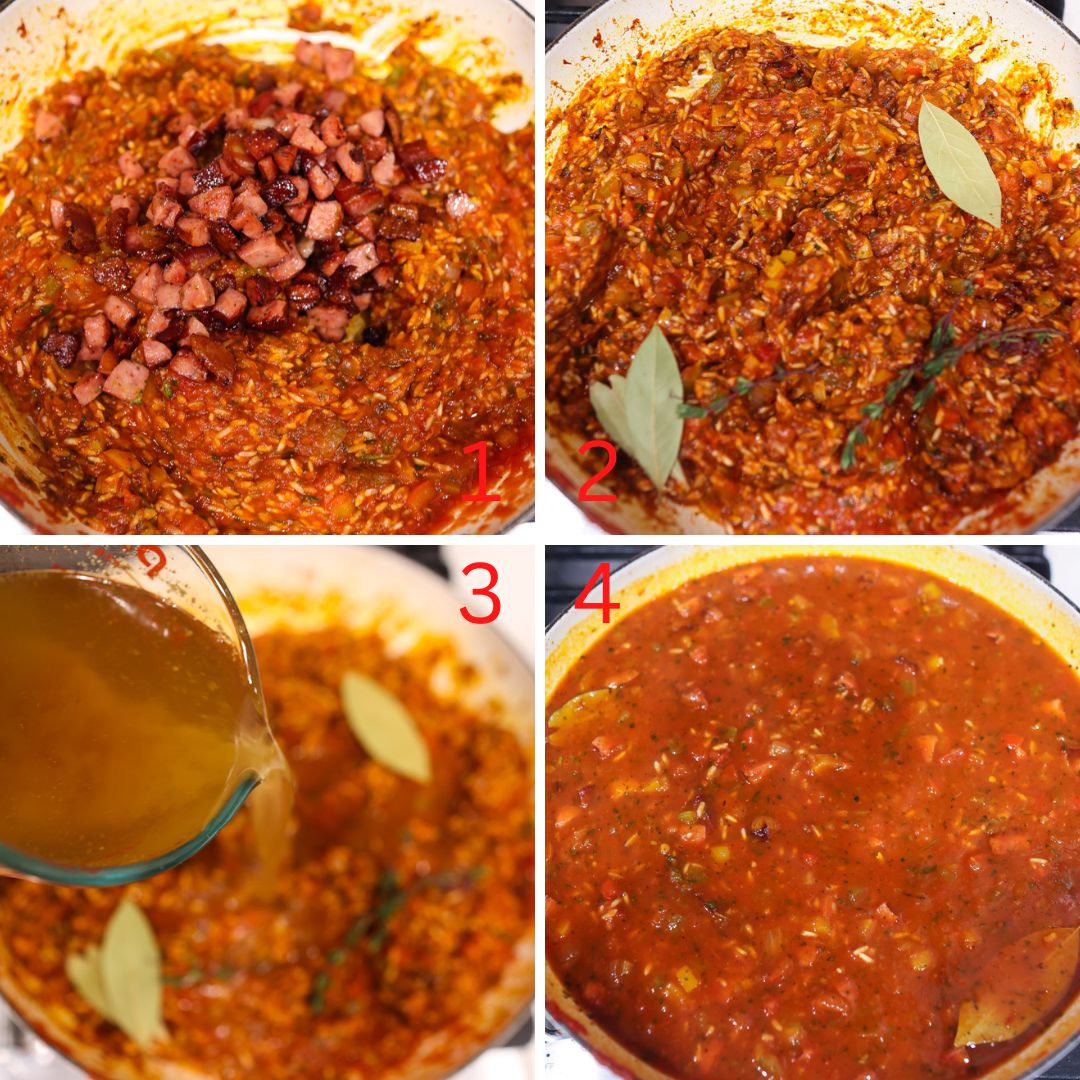
Remove the skillet from the oven from and let rest covered for about 5 minutes
Remove the lid and fluff the rice with a fork. Serve garnished with green onions and fresh parsley.
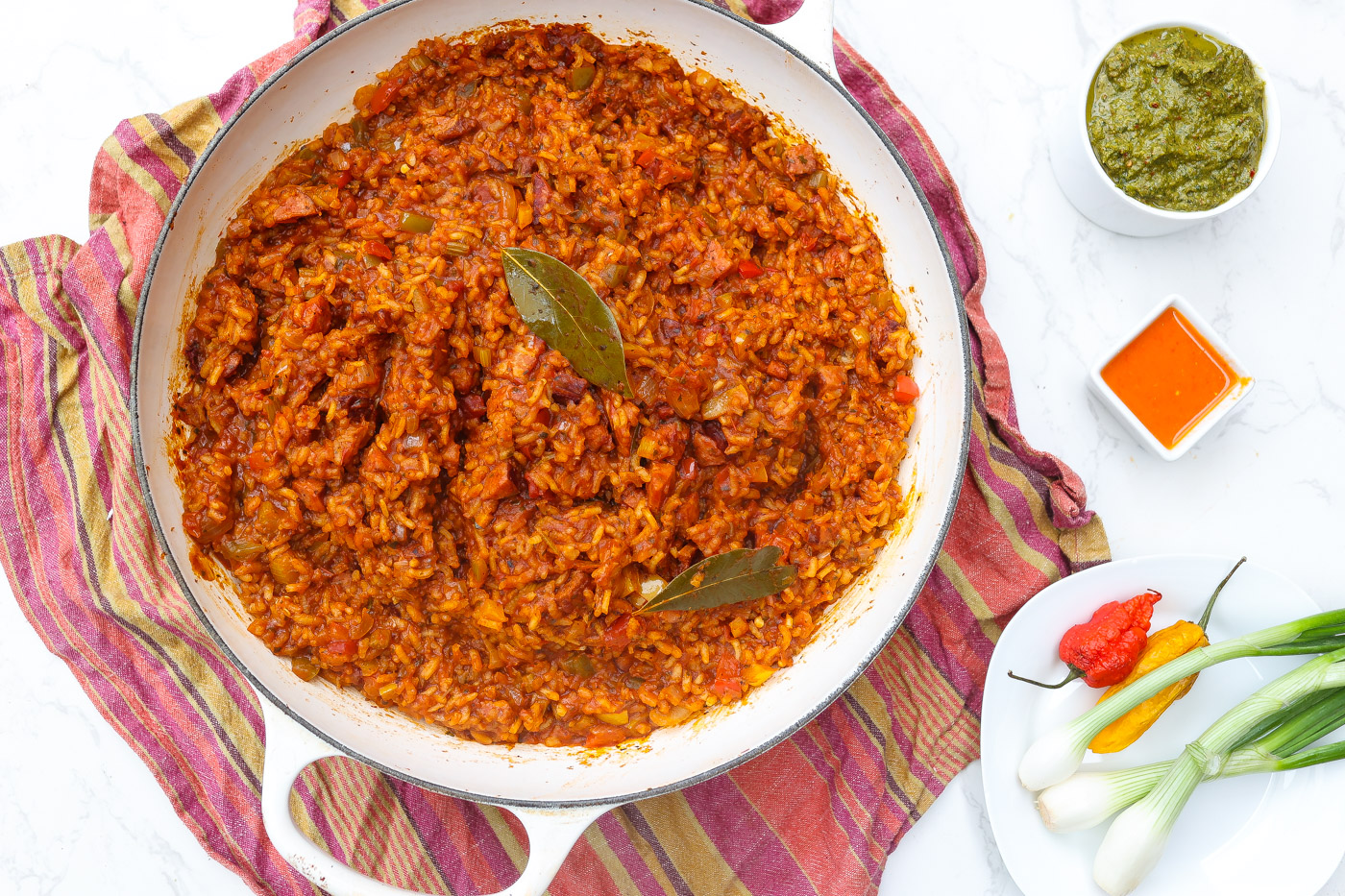
Cooking Tips, Considerations, and Substitutions
Tips for More Flavor
- The key to great red rice is that rich tomato flavor that comes from the tomato paste mixture. I like to use paste plus crushed tomatoes. The paste provides depth to the dish, while the crushed tomatoes is more of that tomato flavor. Both contribute to that deep red color of the rice.
- Epis is a Haitian addition. It is what gives this dish its character and makes it stand out vs. other red rice recipes. It's not a popular ingredient but it's worth it to add it as it elevates this dish quite a bit. I use it on everything from vegetables like green beans to soups/stews.
- Use a good quality smoked bacon as well as andouille sausage. Smoky bacon is a major flavor bomb while the best andouille is well-seasoned and super flavorful.
- If you have the time, make your own chicken stock to use as the main cooking liquid. This allows you to control salt levels and provide a cleaner more natural taste. If you go the store-bought route, then choose a low-sodium version. Store versions contain a lot of salt so be careful.
- Many recipes call for cajun seasoning, but I prefer to use my own spice blend which is based on smoked sweet paprika. Don't worry about adding hot spices like cayenne pepper or red pepper flakes. The hot sauce will add more than enough heat depending on how much you add.
- For that nice fried rice crust you will have to cook on the stovetop.

Substitutions
Here are some common substitutions for ingredients in Gullah red rice recipes:
- Rice: you can substitute brown rice
- Bacon: Pork sausage or ham can be used in place of bacon. I'm a big fan of good andouille sausage, but feel free to use another quality smoked sausage. Kielbasa works well also.
- Onions: Green onions or shallots can be used in place of yellow onions.
- Bell pepper: You can use any color of bell pepper or use poblano or Anaheim pepper.
- Tomatoes: Canned diced tomatoes or tomato sauce can be used in place of fresh tomatoes.
- Hot sauce: Tabasco sauce, chili sauce, or Sriracha can be used instead of hot sauce.
- Chicken broth: Vegetable or beef broth can be used in place of chicken broth.
- Haitian Epis Seasoning Base: Homemade Caribbean Green Seasoning, Homemade or Store-bought Sofrito, a good chimichurri sauce all play the same role and can be used. It won't be the exact same flavor profile, but will help brighten the dish and give it more character.
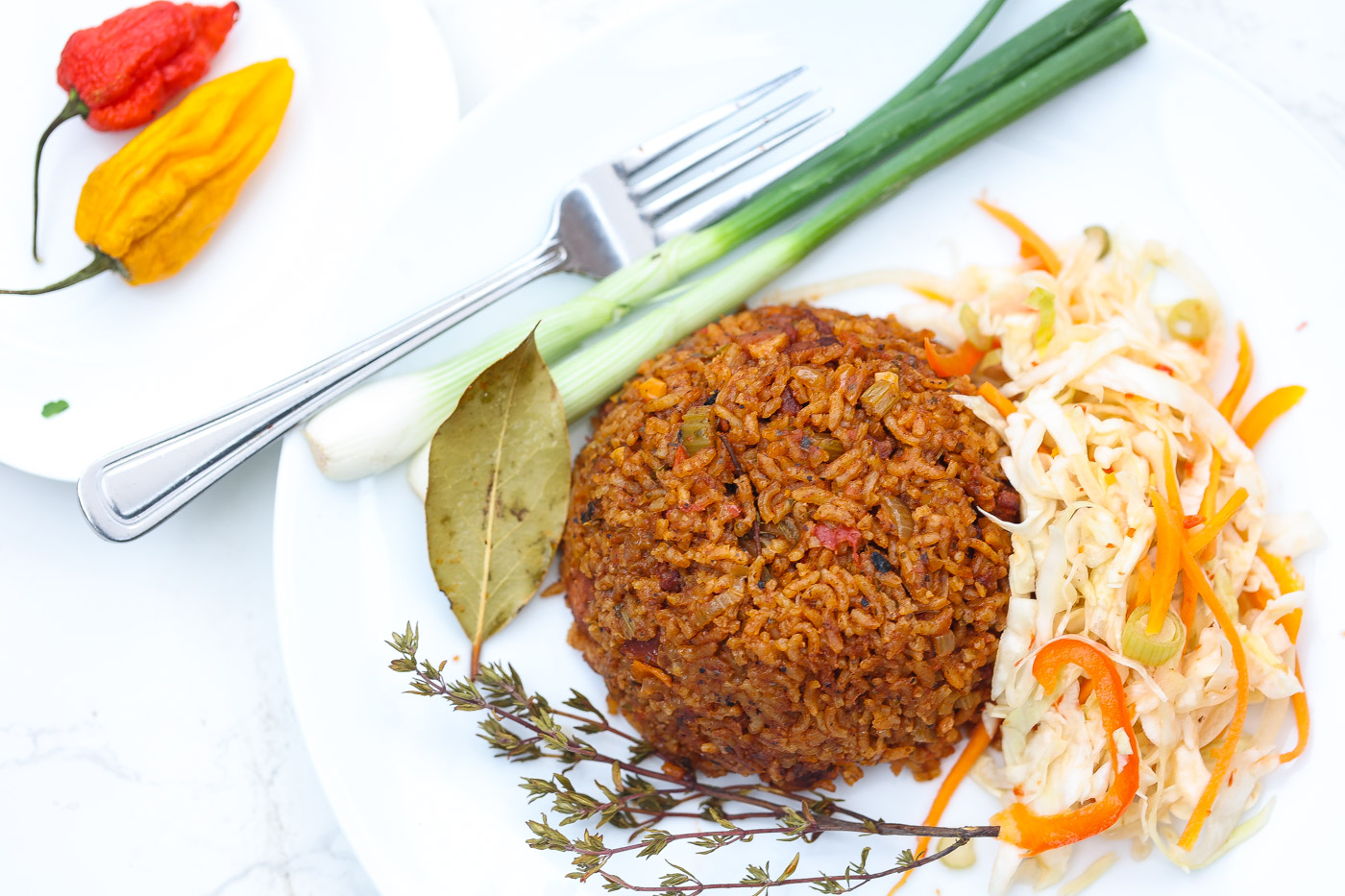
Other Considerations
Here are some key considerations when cooking Gullah red rice:
- Rice type: Use long or medium-grain rice for traditional Gullah red rice as it cooks evenly and has a creamy texture.
- Soaking Rice: Soak the rice in water for at least 30 minutes to help prevent it from becoming mushy. Mushy rice is a no go!
- Cooking Liquid: Use chicken broth for a more authentic flavor, but water or vegetable broth can be used as a substitute.
- Seasonings: Make sure to use a good amount of salt, hot sauce, and other seasonings to add flavor to the dish.
- Rice-to-liquid ratio: Make sure to use the correct rice-to-liquid ratio, usually 1:2, to ensure the rice is cooked correctly.
- Cooking time: Cook the rice for 20-25 minutes on medium heat, stirring occasionally, until the liquid is absorbed and the rice is tender. For fluffy rice allow the cooked rice to rest covered off heat then fluff with a fork.
- Toppings: Add any toppings of your choice, such as chopped bacon, diced onions, and diced bell pepper, before serving.
- Cooking vessel: I wanted to keep everything in the same skillet, basically making this a one-pan dish. But you can using a baking dish. Also I've never used a rice cooker so not sure how this recipe would do.
Remember to taste the rice regularly while cooking to adjust seasonings and cooking times as needed.
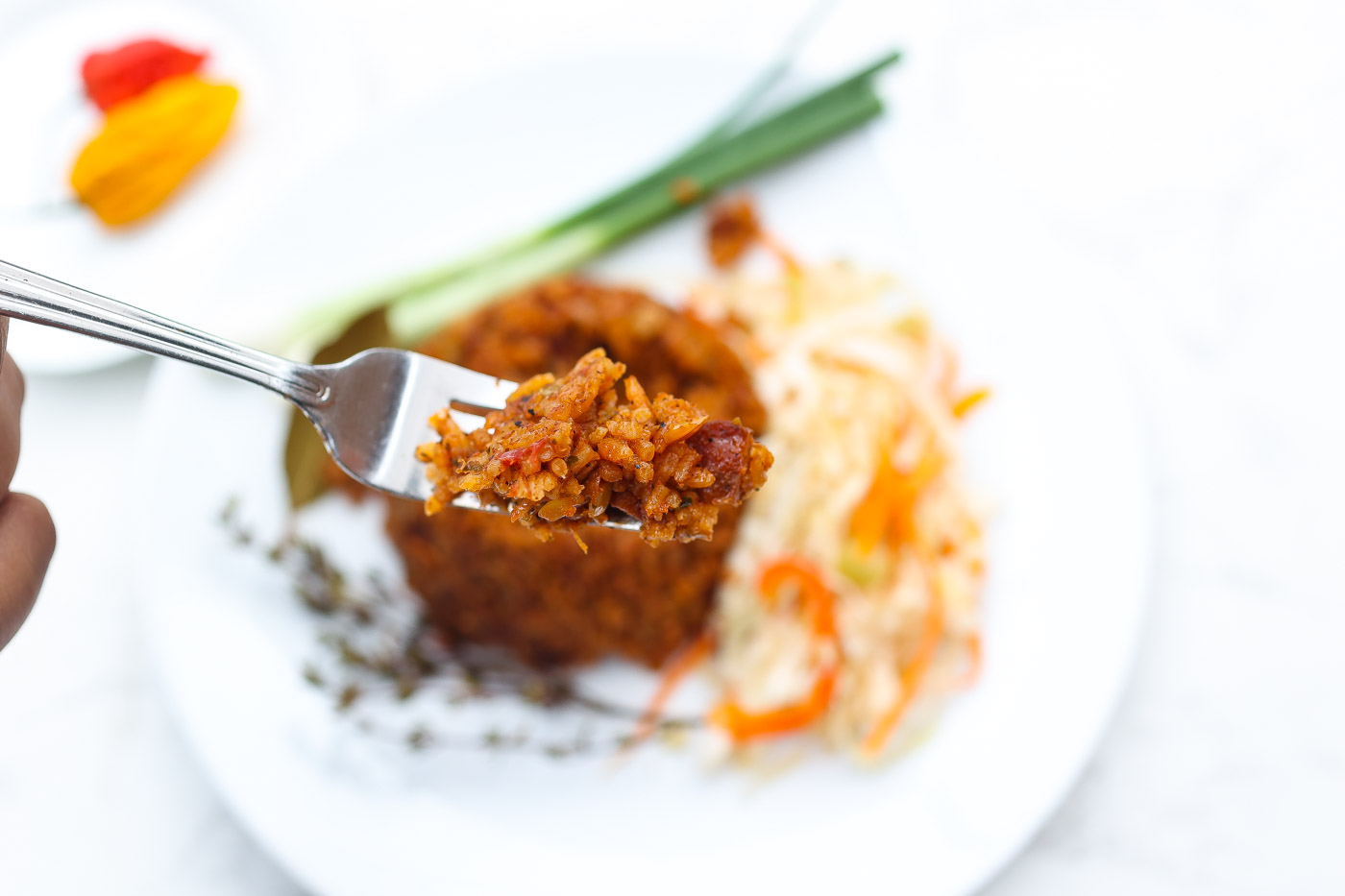
Frequently Asked Questions (FAQs) About Making Red Rice
Baked Rice vs. Stovetop Rice
Traditional red rice is baked in the oven covered. I guess you could cook on the stovetop on low heat. Both methods offer their own unique advantages and disadvantages:
- Baked Rice:
- Advantages: This method allows the rice to cook evenly and results in tender, fluffy grains. It's also convenient as you can add all the ingredients to a baking dish, cover it with foil, and let it bake in the oven without having to stir it.
- Disadvantages: It can be difficult to get the baking time right, and the rice may dry out if left in the oven for too long.
- Stovetop Rice:
- Advantages: This method is quicker and allows for more control over the cooking process. You can adjust the heat, stir the rice, and taste it regularly to ensure it's cooking to your liking.
- Disadvantages: It requires constant attention and stirring to prevent the rice from sticking to the bottom of the pot or becoming mushy.
Ultimately, the best method will depend on personal preference, time constraints, and the type of rice dish you're preparing. Both methods can produce good results if done correctly.
Can I use tomato sauce instead of tomato paste?
Yes, you can use tomato sauce instead of tomato paste to make red rice, although the flavor and texture of the dish may be slightly different. Tomato sauce is thinner and has a sweeter taste compared to tomato paste, which is thicker and has a more concentrated tomato flavor.
To use tomato sauce, you may need to adjust the amount of sauce used and cooking time to achieve the desired consistency and flavor. It's always best to follow the recipe and make any substitutions as needed.
What is the water ratio for red rice?
The water ratio for red rice is typically 2 cups of liquid (water or broth) to 1 cup of medium-grain rice. This ratio helps to cook the rice evenly and produce tender, fluffy grains. However, some recipes may call for a different ratio, so always check the recipe before cooking.
It's also important to note that different types of rice have different absorption rates, so the water ratio may need to be adjusted accordingly.
What to Serve with Charleston Red Rice
I eat my red rice as a side dish though the bacon and sausage make it more substantial. I like mine paired with Haitian pikliz along with fried chicken or fish. I also like to serve with grilled shrimp.
For Other Rice Recipes Try These:
Coconut Ginger Rice
Brisket Fried Rice
Okra Fried Rice
Make This Recipe
Once you've tried this Gullah red rice recipe, you'll understand why it's a staple in so many Lowcountry kitchens. Not only is it easy to make, but it's also packed with flavor. So go ahead and give it a try. We think you'll be hooked after the first bite.
If you make this delicious rice recipe or any other from the site, please come back and leave me a comment below with your feedback. Definitely take a photo of the dish and be sure to tag #foodfidelity so that I can see them.
You can also keep up with my food exploits as well as original recipes! You can find me on Instagram, Facebook, Twitter, and Pinterest. If you like any of the music you find on the site, visit me at Spotify to find curated monthly playlists.
Lastly, go to my YouTube channel and subscribe to be notified when new weekly videos are uploaded.
Ingredients
For the Rice
- 1 ½ cups Long grain rice - Carolina Gold Rice or Jasmine Rice
- 1 tablespoon Olive oil
- 4 slices Thick cut bacon diced
- 3 Andouille sausage links diced
- 4 Garlic cloves minced
- 1 medium Yellow onion diced
- 1 cup tri-color peppers diced
- 2 Celery stalks diced
- 6 oz. Tomato paste
- 8 oz Crushed Tomatoes
- ½ cup Haitian Epis Seasoning Base
- 1 tablespoon Hot Sauce
- 2 ½ cups Chicken Stock
- 2 Bay leaves
- 3 Fresh Thyme sprigs
Spice Seasoning Mix
- ½ teaspoon Dried thyme
- 1 teaspoon Kosher Salt
- 1 teaspoon Black Pepper
- 1 teaspoon Smoked Paprika
- ½ teaspoon Allspice
Instructions
Make The Spice Seasoning Mix
- Place all the spices in a small mixing bowl or ramekin and mix well. Set aside
Prepare the Rice
- Rinse the rice in your sink until the water runs clear. Drain and set aside.
Cook the Rice
- Pre-heat the oven to 350 degrees F.
- Add oil to large saucepan or cast-iron skillet and fry the bacon on low heat. Cook stirring often until bacon crisps about 5 minutes and the fat renders
- Increase heat to medium heat. Add the andouille sausage and cook another 3-4 minutes. Remove both the bacon and sausage and set aside on a paper towel lined bowl or plate.
- Add onions and celery to the skillet and cook 5 minutes.
- Add the peppers, garlic, and a quarter of the spice mix and cook for another minute.
- Add the tomato paste and half the remaining spices and cook stirring frequently for about 8-10 minutes.
- Add the rinsed rice and stir until coated well by the tomato paste mixture. 3-4 minutes
- Add the Haitian Epis, crushed tomatoes, and hot sauce. Mix well. Turn off the heat and add bacon plus sausage back. Then add the chicken stock, fresh thyme, and bay leaves. Cover the skillet with a tight fitting lid or with aluminum foil and bake 25-30 minutes.
- Remove the skillet from the oven from and let rest covered for about 5 minutes
- Remove the lid and fluff the rice with a fork. Serve garnished with green onions and fresh parsley.
Notes
- The key to great red rice is that rich tomato flavor that comes from the tomato paste mixture. I like to use paste plus crushed tomatoes. The paste provides depth to the dish, while the crushed tomatoes is more of that tomato flavor. Both contribute to that deep red color of the rice.
- Epis is a Haitian addition. It is what gives this dish its character and makes it stand out vs. other red rice recipes. It's not a popular ingredient but it's worth it to add it as it elevates this dish quite a bit. I use it on everything from vegetables like green beans to soups/stews.
- Use a good quality smoked bacon as well as andouille sausage. Smoky bacon is a major flavor bomb while the best andouille is well-seasoned and super flavorful.
- If you have the time, make your own chicken stock to use as the main cooking liquid. This allows you to control salt levels and provide a cleaner more natural taste. If you go the store-bought route, then choose a low-sodium version. Store versions contain a lot of salt so be careful.
- Many recipes call for cajun seasoning, but I prefer to use my own spice blend which is based on smoked sweet paprika. Don't worry about adding hot spices like cayenne pepper or red pepper flakes. The hot sauce will add more than enough heat depending on how much you add.

